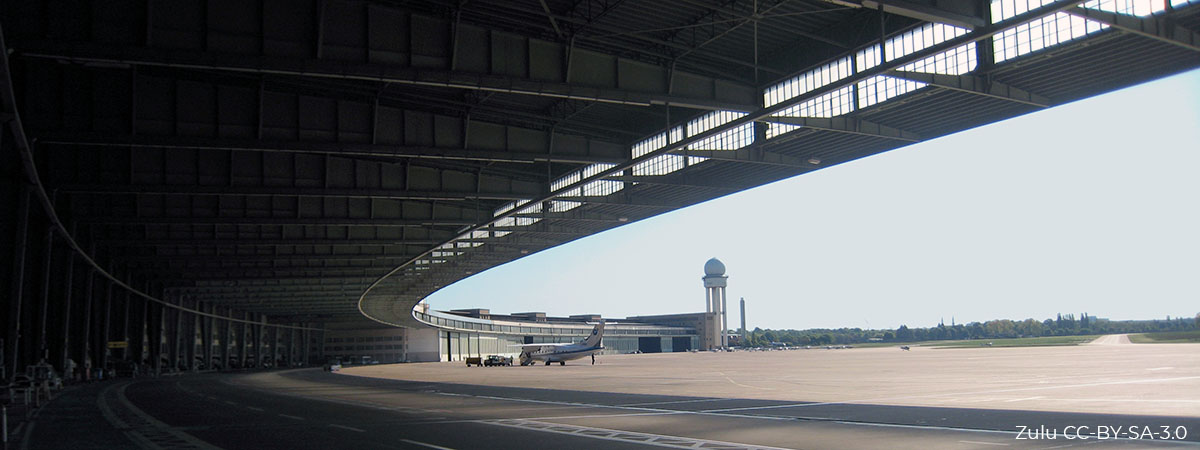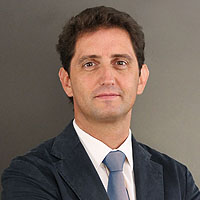The chronological simultaneity of the triumph of the 20th century avant-garde with the most dazzling development of commercial aviation in the inter-war period was more than a historical coincidence for architecture. The relationship established between the predominant current of thought at that time, with its leading figure Le Corbusier at its head, and the highly technological and emerging aeronautical universe, was practically immediate. Indeed, modernity established that avant-garde architecture should be identified with technological progress, and of course, flying had become a symbol of that progress.
In the middle of the last century, rationalisation, industrialisation and prefabrication made their way into the design of airports and these concepts have never ceased to be present in their design.
It is therefore not surprising that Le Corbusier himself, whose ideal for housing was the machine for inhabiting – machine à habiter – showed his enthusiasm for aeronautics and all that it represented. Some authors even describe this enthusiasm as a genuine obsession,[1] especially regarding the most representative element of this universe: the aeroplane, the flying machine. But in addition to the obvious rationalist connection and the common complicity in achieving the ideal of “modern life”, the Swiss architect’s obsession had another fundamental aspect, which can be extracted from his own writings.[2]
Revolutionising the world and achieving a bird’s eye view – that’s how, in addition to changing our perception of the world (and of course, its size), these fantastic devices offered a new tool for the practice of the profession: aerial photography. The changes brought about by the awareness of this new point of view are what led Le Corbusier in 1935 to declare a more than significant “the aeroplane indicts”.[3]
In a way, this duality meant that the modern movement found in the design of airports a battering ram for its principles: eminently functional buildings, with attractive aeronautical forms and which could be seen in their entirety as planes take off and approach landing. Despite all this, the examples that have come down to us today are not very numerous and none of them, with a few exceptions, can be identified with the legacy left to us by the modern movement and the eclectic situation that followed it in the second half of the 20th century.
Moreover, for some reason, the results seen in the first half of the century seemed to have “given way” to the more austere “international style”, being confined to cold, rectilinear and forceful volumes.
It is quite possible that this emptiness is partly caused by the strange nature of passenger terminals: ephemeral, changing buildings, but constructed with enormous technological, economic and planning effort. Always adding, never subtracting.
The inhabiting machine opened the way to rationalisation, industrialisation and prefabrication. It had to be a useful object, manufactured by assembling industrialised parts taken from the “box of construction elements” [4] promulgated by Le Corbusier. Just like an aeroplane. All the more so in an airport.
However, as mentioned above, not many interesting proposals have been put forward to date with regard to this new programmatic typology. Perhaps the most striking is the one sketched by Erich Mendelsohn in 1914,[5] a kind of large hangar with forms evoking aeronautical aesthetics.

This building is a faithful reflection of the Expressionism that the architect of the so-called “first generation” would use only three years later in his Einstein Tower in Potsdam. His way of composing the elements seems to anticipate the terminals of today rather than those that were to come chronologically. In fact, years later, a disciple of Mendelsohn, Ernst Sagebiel, would sign off what has been practically the only airport terminal that has remained operational to the present day (it ceased its activity in 2008): Tempelhof, in Berlin, one of Hitler’s dreams, baptised as the mother of all airports by Foster .[6]
It is clear that in the use of technical advances, such as reinforced concrete, the masters saw the solution to many of the challenges posed by their new architecture. It was through the use of this material that Le Corbusier set out the five points of this new architecture.[7] Beyond these five points, two of them would prove to be basic to the organisation of the terminals of the future: the free plan – the load-bearing walls no longer delimit the floor plan and, therefore, the different levels of the building have the same layout – and the large openings in the façade.
But the impact of aviation on the architects’ way of thinking was not exclusively focused on the terminal buildings. Obviously it was – and is – the most representative building of an airport. However, it is the airfield itself, as well as all the elements that will gradually proliferate around it, that really have – and will have – an immense impact, not only on its immediate surroundings, but on the complicated and unstable balance of realities that our cities are today – in terms of energy, resources, mobility and, of course, morphology.

[1] Bibián Diaz, Concepción, (2014). Arquitectura de Aeropuertos (The Architecture of Airports). Cuaderno de notas 15 (Notebook 15). P.19
[2] Le Corbusier, (1938). La vía aérea. (The Aerial Way)
[3] Le Corbusier, (1938). La vía aérea. (The Aerial Way) We knew that our cities were unworthy, despised by the majority of their inhabitants and that they would remain indifferent to reason, to society, to the family and to all sentient beings. We knew this, but we did not suspect the extent of the filth and the city’s dishonesty towards its inhabitants. The plane observed, informed and indicted us.”
[4] Le Corbusier (1923). Towards an Architecture. The house, understood as a machine, must be a useful object, manufactured by assembling industrialised parts in the same way as a car, an aeroplane or a ship. This is why we need to create the “Box of Construction Elements” that will make the industrialisation of Architecture possible.
[5] In 1914, Mendelsohn had designed a spectacular airfield of enormous dimensions. With curved lines, a high central hall extended into a low horizontal body to receive up to six aircraft, with aircraft hangars and workshops on each side http://vaumm.com/tempelhof-el-aeropuerto-de-hitler/
[6] Until the building of the Pentagon, Tempelhof was the largest building in the world. Norman Foster described it as “the mother of all airports”. (Reference)
[7] Le Corbusier and P. Jeanneret (1926) Five Points of a New Architecture. A document in which some of the ideas, developed in previous years, are systematically presented.


